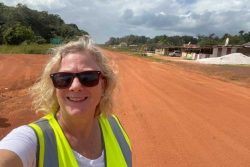Dear Editor,
Please allow me space in your newspaper to discuss SARS-coronavirus-2 and COVID communication. I am writing this on my birthday, March 20th, the first full day of Spring in the northern hemisphere. I have been at home under self-isolation to avoid infection from the SARS-coronavirus-2.
Having spent some time studying molecular biology and working in such laboratories, I feel that it is perhaps helpful for me to communicate some basic ideas to the readership of the Stabroek News.
The SARS-coronavirus-2 is so named because it is related to the SARS-coronavirus-1 (severe acute respiratory syndrome) virus which is thought to have emerged in China in 2003. It causes a flu-like disease called Coronavirus Disease 2019 (COVID-19).
Corona viruses are a family of viruses, so named because of their structure when observed under microscope. Viruses are not classified as living things because they cannot reproduce on their own, but require the cell of a host organism. Also important, is that viruses can only use certain cells to reproduce. This means that a virus requires a certain organism and a certain cell type within that organism to reproduce. It’s like a lock-and-key parasitic relationship between a virus and the cell-type it can infect. Because the molecules on a type of cell in one mammal has some similarity to the same type of cell in another animal, a virus is likely to infect the same type of cell across animals e.g. respiratory epithelial cells.
Corona viruses are known to cause the common cold in humans. What is different about the SARS-coronavirus-2, is that it is new to humans, just like its predecessor, SARS. The virus is thought to have used a certain species of bats as a reservoir host where it exists in some sort of stable relationship i.e. doesn’t kill the host. That means that the virus evolved with this certain species of bats to reproduce. Because the virus relies on the bats to survive, it is likely that it causes little disease. It may have also infected an intermediate host, or an animal which bridges the bats to humans. In the case of SARS-coronavirus-2, it is thought to be a type of anteater. This anteater, the pangolin, was being sold as a food animal in a market which brought it into close contact with humans.
Because it is new to humans, our immune systems are naive to it. This results in acute illness in some persons as the immune system goes into an all-or-nothing attack, called a ‘cytokine storm’. In others, the virus infects without acute illness, but is still shed. The ratio of how many people become acutely ill to those who are mild or asymptomatic (carriers) is still being investigated. This is the reason for heightened international response. It is important to study and understand how this new type of corona virus behaves in the human population. In a world of 8 billion people with constant flying between continents, we have seen how a virus can emerge in one small area of the world and suddenly spread. In the case of a respiratory illness that can be shed from an asymptomatic person without realizing it, it becomes even more worrisome. Because different cultures behave differently and live in different environments, how a virus is spread in one community does not predict how it will in another.
Viruses hijack cells and use them to reproduce. The body’s attempts to clear the virus, causes the symptoms we des-cribe as disease – inflammation, fever, increased phlegm production, coughing and body ache. With SARS-coronavirus-2, the cell type that is infected is the epithelial cells that line the respiratory tract which leads to sneezing and coughing, and severe scarring of the lungs. The tiny respiratory droplets that are expelled when someone coughs, spreads viral particles on surfaces around us, and even into the nose and mouths of those unlucky enough to be close to us. One of the ways that the body clears viruses is through a signaling system that leads to marking invading molecules for degradation.
The current tests on the market are effective only when a person is actively infected with the virus. A vaccine takes even longer as it requires the virus to be isolated and grown reliably in a laboratory. The best mode of being safe at this time is in behavioural changes and precautions.
The SARS-coronavirus-2 is known to remain viable for up to 3 days on hard surfaces. This means that viral particles that settle on hands, cheeks, cups, desks, computer keyboards, light switches and vegetables in an open-air market can remain infectious for a significant length of time. Since human hands are used to communicate by touch, explore physical attributes of objects and keep our faces free of irritants, we have a propensity to touch things around us and then our faces frequently. Our faces are where we have many entries to our respiratory system – nostrils, eyes and mouth. We do it without thinking about it. Changing this behaviour at this time is very helpful. It is also helpful to laugh, cough and sneeze using a tissue or rag to prevent viral particles from jumping from one person to another. It is also helpful not to eat fresh foods that are sitting on an open-air shelf without washing them.
This is why I am self-isolating, and why it is the most effective method of combating the spread of the disease. I am keeping the surfaces around me clean, and training myself to wash my hands frequently, avoid touching my face, and washing things that come into contact with my face. I am also sneezing into my shirt or into a tissue so that viral particles aren’t spread. I am hoping others do the same. It is imperative that everyone takes precaution in being vigilant about their behaviour and how it exposes themselves and others to infection. As the world changes so must we. This is especially true when our healthcare system and testing capacity is limited.
I invite the science and medical community in Guyana to add to this discussion, and perhaps, make it an active forum for continued education.
Yours faithfully,
Gregory Kanhai









